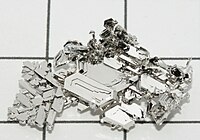
Photo from wikipedia
ABSTRACT Contrasting the big family of the planar tetracoordinate carbon (ptC), species featuring the planar tetracoordinate heavier group element M (ptM) have been largely limited. Effective structural frameworks to accommodate… Click to show full abstract
ABSTRACT Contrasting the big family of the planar tetracoordinate carbon (ptC), species featuring the planar tetracoordinate heavier group element M (ptM) have been largely limited. Effective structural frameworks to accommodate such ptM centres are thus highly desired. In the present article, we report an extensive computational study on 60 pentatomic systems C2X2Yq (X=Si,Ge,Sn,Pb; Y=C,Si,Ge,Sn,Pb; q = +1,0,−1) covering both the low and high spin states. Up to 34 systems were shown to have the very low-lying singlet planar tetracoordinate heavier group 14 (ptM with M=Si,Ge,Sn,Pb) structures bearing the 19 (q = +1), 20 (q = 0) and 21 (q = −1) valence electrons (ve). Structural and bonding analysis confirmed the effectiveness of the inherent π-type ligand skeleton XCCX or XCCY that each have several sets of π-bonding orbitals to stabilise the ptM centre. The structural and bonding motifs of these ptMs differ greatly from the classic ptMs, which have the σ-type ligand skeleton, smaller number of valence electrons (≤18ve), and the centre → ligand π-delocalisation.
Journal Title: Molecular Physics
Year Published: 2018
Link to full text (if available)
Share on Social Media: Sign Up to like & get
recommendations!